
We’re all just doing our best to survive in a world with too many cleaning products and too little time. While I’m addicted to the Lakeland catalogue as much as the next domestically obsessed person, when I’m cleaning my own bathroom, I use one multipurpose cleaner, the odd application of bicarbonate of soda and vinegar, a mountain of microfibre cloths, old toothbrushes for detailed scrubbing, and bleach for the loo. My routine takes 10 minutes, max.
But once every few weeks, I pay closer attention to areas that benefit from a deeper clean. I don’t do all of them every month: often I pick one and rotate them, so that everything gets a turn – though of course I deep clean the loo more often.
Shower curtain
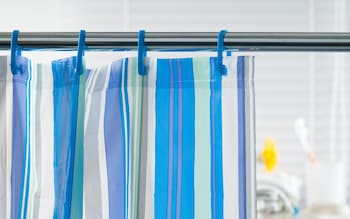
Stand by for a horrifying statistic. A 2023 study found that your shower curtain may harbour 60 times more bacteria than your loo seat, with the warmth and moisture of the shower creating the perfect environment for germs to proliferate. Gentle, regular cleaning is essential, and also helps to prolong the life of your shower curtain. Make sure each time you use the shower you open out the shower curtain as far as possible and don’t leave it bunched up, which encourages the growth of bacteria.
Every couple of months, wash your shower curtain and liner. Remove it from the rings – take this opportunity to give the rings a quick wash in some warm, soapy water – and put it through the delicate cycle of your washing machine.
Toss a teacupful of bicarbonate of soda in the drum with the curtain, add the same amount of white vinegar to the fabric conditioner drawer, and use half the quantity of detergent you would normally use.
Put a towel in with the curtain as this will help “scrub” it during the spin cycle and prevent excessive creasing.
Finally, either line dry it, or reattach it to the rings and let it drip dry inside the bath.
Extractor fan
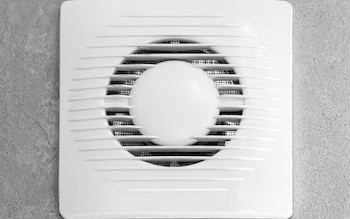
The extractor fan is the unsung hero of the bathroom. It removes moisture and what are poetically called “airborne contaminants”, helping to ensure your bathroom remains sanitary and mould free. Fold a little gentle, weekly TLC into your weekly bathroom cleaning by giving the grille a go over with the crevice tool on your vacuum cleaner, or by dusting it with an extendable-handled microfibre duster, then once or twice a year (depending on how often the bathroom is used) give it the full spa treatment.
First, and most importantly, turn off the power to the fan; there should be an isolator switch nearby, or failing that, turn it off at the main fuse box.
Dust the extractor to remove any surface dirt before removing the cover either by releasing the clips or undoing any screws with a screwdriver.
Place the cover in a bowl of soapy water for five minutes, then rub it gently with a sponge or microfibre cloth to remove stubborn dirt before rinsing and leaving on a clean tea towel to dry completely. If there’s a filter, remove it, wash it (or replace it, depending on the manufacturer’s instructions) and place it to dry with the extractor cover.
Use your duster or vacuum cleaner crevice tool to clean inside the unit. Soak a microfibre cloth in hot water then wring it out as tightly as you can and clean the inside of the unit.
Make sure everything is absolutely bone dry before reassembling the unit.
Door handles and light switches/pulls
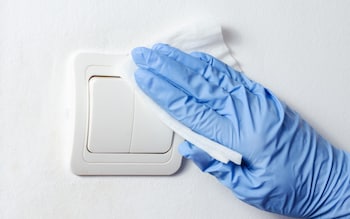
I know you’re a person of immaculate good habits, but I’m here to break it to you that there are those who aren’t and they walk among us. They look like decent human beings; we’re even related to some of them. I speak of people who use the bathroom and then don’t wash their hands. In your weekly cleaning, don’t forget to give door handles, light switches and light pulls on either side of the bathroom door some attention.
Take a microfibre cloth, spray it very lightly with antibacterial cleaner, being very careful not to get it wet – you want it barely damp. (You could also clean switches when you have the electricity turned off to clean the extractor fan.)
Wipe door handles, light switches and light pulls. With light pulls, be sure to clean the rope or chain part too.
The “forgotten” bits of the sink
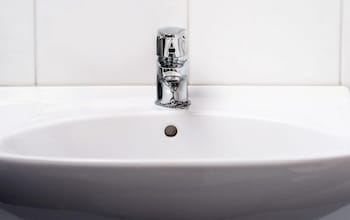
During the most cursory bathroom cleaning, we all give the sink a wipe, but we sometimes forget the underside of freestanding sinks, where soapy residue can build up. Remember to wipe that too – it will take a couple of seconds to clean if you do it regularly. The same goes for the back of the pedestal on a freestanding sink.
The plughole, drain and overflow hole also need regular attention. Include the plughole, plug or pop-up plug in your weekly cleaning, as they can become grimy quite quickly. Simply wash with all-purpose cleaner and buff dry with a microfibre cloth.
The drain itself can become clogged with soap residue, cosmetics, hair products and shaving debris, so at least once a month give it a thorough clean.
Tip a teacupful of bicarbonate of soda down the plughole, followed slowly by two cups of white vinegar. Let it sit for 15 minutes to an hour then pour down a kettle of boiling water.
Two or three times a year, it’s a good idea to do this to the overflow hole too, using a funnel to tip the bicarb, vinegar and boiling water into the hole.
Nooks and crannies on the loo
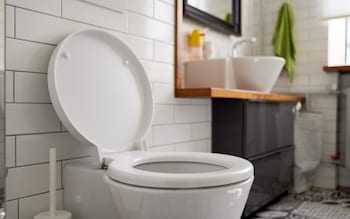
No one wants to, but we’ve all got to – clean behind the back of the loo, that is. And while we’re at it, give the loo seat a proper deep clean every couple of weeks, on top of your regular cleaning.
Use an old toothbrush to scrub the hinges and other fixings with all-purpose cleaner, before washing down with a cloth soaked in dilute cleaner and wrung out well.
Don’t forget to clean the loo roll holder and its holder too. Put a slug of bleach in the holder each week to help keep the brush clean, and replace it often.
Toothbrush holder and associated gubbins
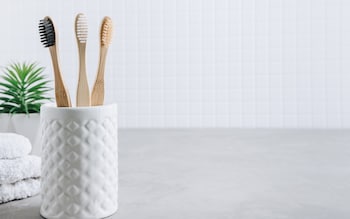
Bear with me while I confess my deep paranoia about grotty toothbrushes. If I’m sharing a bathroom, either home or away, with anyone other than my fastidious husband, I put my toothbrush away in the cupboard after I use it. Why? Because once you’ve read that terrifying statistic about quite how far particles of water and, along with it, urine and faeces, can travel every time you flush the loo, you are forever changed.
Pathogens such as E. coli, norovirus and C. difficile can remain in the bowl even after a dozen flushes. Not everyone puts the seat down after they’ve used the loo.
Even if you put your toothbrush away, your toothbrush holder, the shelf above the sink that may hold your beauty products, hairbrushes and so on, can become a smorgasbord of bacteria.
Wipe down the area regularly using an antibacterial cleaner and wash the cup part of your toothbrush holder or put it through the dishwasher as often as possible, but at least twice a week.
Disclaimer: The copyright of this article belongs to the original author. Reposting this article is solely for the purpose of information dissemination and does not constitute any investment advice. If there is any infringement, please contact us immediately. We will make corrections or deletions as necessary. Thank you.



